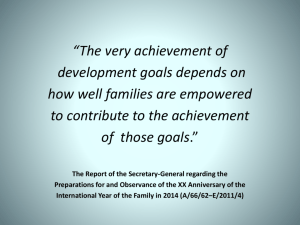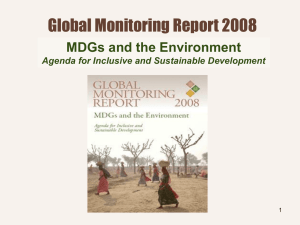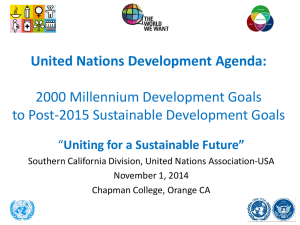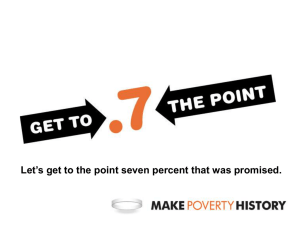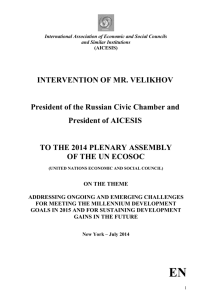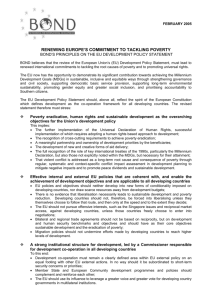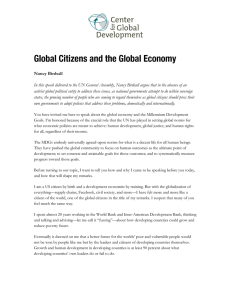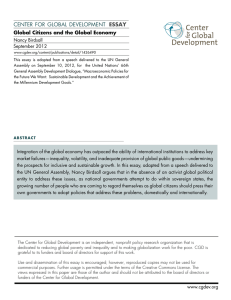UNCTAD N° 14, June 2010 Towards more inclusive development strategies
advertisement
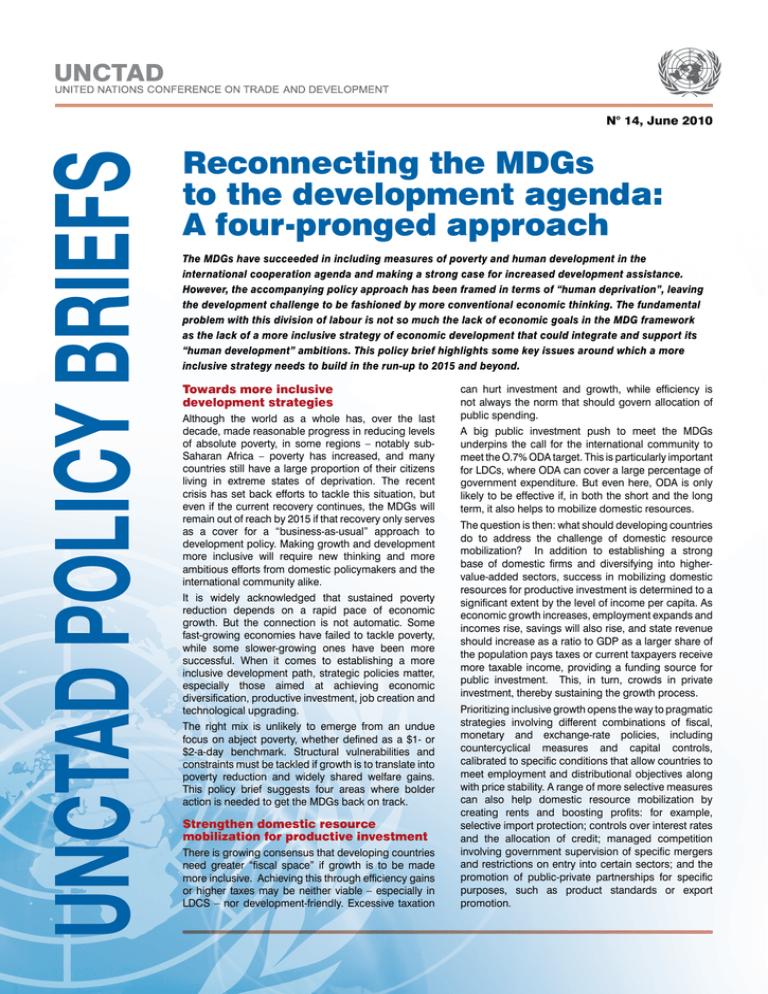
UNCTAD UNCTAD POLICY BRIEFS N° 14, June 2010 Reconnecting the MDGs to the development agenda: A four-pronged approach The MDGs have succeeded in including measures of poverty and human development in the international cooperation agenda and making a strong case for increased development assistance. However, the accompanying policy approach has been framed in terms of “human deprivation”, leaving the development challenge to be fashioned by more conventional economic thinking. The fundamental problem with this division of labour is not so much the lack of economic goals in the MDG framework as the lack of a more inclusive strategy of economic development that could integrate and support its “human development” ambitions. This policy brief highlights some key issues around which a more inclusive strategy needs to build in the run-up to 2015 and beyond. Towards more inclusive development strategies Although the world as a whole has, over the last decade, made reasonable progress in reducing levels of absolute poverty, in some regions – notably subSaharan Africa – poverty has increased, and many countries still have a large proportion of their citizens living in extreme states of deprivation. The recent crisis has set back efforts to tackle this situation, but even if the current recovery continues, the MDGs will remain out of reach by 2015 if that recovery only serves as a cover for a “business-as-usual” approach to development policy. Making growth and development more inclusive will require new thinking and more ambitious efforts from domestic policymakers and the international community alike. It is widely acknowledged that sustained poverty reduction depends on a rapid pace of economic growth. But the connection is not automatic. Some fast-growing economies have failed to tackle poverty, while some slower-growing ones have been more successful. When it comes to establishing a more inclusive development path, strategic policies matter, especially those aimed at achieving economic diversification, productive investment, job creation and technological upgrading. The right mix is unlikely to emerge from an undue focus on abject poverty, whether defined as a $1- or $2-a-day benchmark. Structural vulnerabilities and constraints must be tackled if growth is to translate into poverty reduction and widely shared welfare gains. This policy brief suggests four areas where bolder action is needed to get the MDGs back on track. Strengthen domestic resource mobilization for productive investment There is growing consensus that developing countries need greater “fiscal space” if growth is to be made more inclusive. Achieving this through efficiency gains or higher taxes may be neither viable – especially in LDCS – nor development-friendly. Excessive taxation can hurt investment and growth, while efficiency is not always the norm that should govern allocation of public spending. A big public investment push to meet the MDGs underpins the call for the international community to meet the O.7% ODA target. This is particularly important for LDCs, where ODA can cover a large percentage of government expenditure. But even here, ODA is only likely to be effective if, in both the short and the long term, it also helps to mobilize domestic resources. The question is then: what should developing countries do to address the challenge of domestic resource mobilization? In addition to establishing a strong base of domestic firms and diversifying into highervalue-added sectors, success in mobilizing domestic resources for productive investment is determined to a significant extent by the level of income per capita. As economic growth increases, employment expands and incomes rise, savings will also rise, and state revenue should increase as a ratio to GDP as a larger share of the population pays taxes or current taxpayers receive more taxable income, providing a funding source for public investment. This, in turn, crowds in private investment, thereby sustaining the growth process. Prioritizing inclusive growth opens the way to pragmatic strategies involving different combinations of fiscal, monetary and exchange-rate policies, including countercyclical measures and capital controls, calibrated to specific conditions that allow countries to meet employment and distributional objectives along with price stability. A range of more selective measures can also help domestic resource mobilization by creating rents and boosting profits: for example, selective import protection; controls over interest rates and the allocation of credit; managed competition involving government supervision of specific mergers and restrictions on entry into certain sectors; and the promotion of public-private partnerships for specific purposes, such as product standards or export promotion. UNCTAD Put inequality back on the policy agenda The rapid deregulation of financial markets – the defining feature of our globalizing era – has been accompanied almost everywhere by an increase in inequality, oftentimes a sharp one. This trend offers a possible explanation of why strong growth and weak human development coexisted in many developing countries during the recent cycle. Figure 1 plots the average Gini index over the period 2000-2008 against the average headcount poverty rate for the same time interval; it suggests a weak but positive association between inequality and the share of population earning less than $2 a day. The association is stronger for other goals. In fact, the evidence indicates that economic growth may even worsen the situation of vulnerable people and communities where income distribution is unequal. The policy implication is clear: making economic growth more inclusive requires that public investment in productive sectors, employment and income distribution – downplayed in the conventional policy advice of recent years – be placed on an equal footing with price stability in the design of more inclusive development strategies. Indeed, there is increasing evidence that greater inclusion is also good for economic growth. % of Population under 2$ Poverty Line 60 20 40 Figure 1. The positive link between equality and poverty reduction corruption and an independent judiciary. While these can no doubt help to strengthen state structures, they do not exhaust the capacities required of a developmental State to establish a stable framework for economic activity and with sufficient flexibility to adapt policy goals and make trade-offs in line with changing local conditions and constraints. The recent fixation with rolling back the economic agenda of the State has done little to advance the political economy of poverty reduction. Moving to more inclusive development strategies implies adding more policies to the development toolkit and using them more pragmatically. In many developing countries, success has been managed by “developmental States” that have raised investment to fuel economic growth, and that have guided that investment into activities that could generate jobs and sustain a high-wage future for their citizens. This should not be taken to imply that States are invincible or unable to fail, which is clearly not the case. Nor is it to deny that Statebuilding in many developing and transition economies will have to tackle dysfunctional and sometimes corrupt administrations. But what is important to remember is that institutions emerge through long and at times painful historical processes, and many that are now regarded as prerequisites of successful economic development were the outcomes, rather than the causes, of economic development in today’s advanced nations. Moreover, there is considerable institutional diversity even among industrial countries today. This should provide a sizeable opportunity for sharing experiences about institutional change, particularly among developing countries, but also serves as a reminder that imposing a common institutional standard on all countries, with widely varying conditions, is likely to be counterproductive. 0 20 40 Gini Index, average 2000-2008 Fitted values 60 (mean) Gini Source: World Bank, World Development Indicators This appears to be particularly important in the rural sector, where measures favouring small-scale producers can help improve social welfare and enhance food security. More generally, reducing inequality tends to encourage a faster expansion of the domestic market, ensuring economies of scale, improving access to domestic savings and building greater resilience to external shocks. Measures ranging from public works and cash transfer programmes to a minimum wage or a guaranteed social floor need to be considered. Contrary to recent trends, such measures are best pitched as universal policies rather than specifically targeted at the poor because they are likely to achieve broader political appeal, especially with support from the middle classes, and have some clear administrative and cost advantages. Build strong States with a developmental vision The governance agenda has served as a useful reminder that institutions matter when it comes to mobilizing resources and tackling inequalities. However, loan, aid and debt-relief conditionalities have tended to promote an ambitious reform agenda based on a highly stylized set of “good” attributes, such as transparency, anti- The most effective development assistance programmes have combined financial generosity and ideological tolerance with a high degree of local ownership and control. In recent years, aid has lagged significantly behind what is needed to support inclusive development. However, it is not just the quantity but also the quality of aid that raises concerns. The fragmentation of aid disbursements has contributed to incoherence in national development policies, including a resource bias towards the social sectors. At present, there is no permanent multilateral forum in which issues surrounding the scale and use of aid flows, its impact on national policy coherence, and the repercussions of shortfalls in aid commitments – especially internationally agreed and time-specific targets – can be rigorously addressed from the perspective of potential recipients. Such a new international architecture for aid must also ensure, first and foremost, that the aid is used to encourage and supplement domestic resource mobilization and to fill the gap between national rates of saving and investment needed to meet national development goals, including the MDGs. Putting the MDGs back on track requires that development cooperation moves beyond the debate about aid effectiveness and seeks to build much greater coherence across all elements of the international system to better support efforts to mobilize domestic resources for inclusive growth and development. Destabilizing linkages between trade and finance have so far met with piecemeal responses and in many cases are themselves a thorn in the smooth functioning of the trading system. In light of recent developments, the place to begin a more systematic approach to coherence is with the problem of international indebtedness. The current crisis has again demonstrated that the international financial system would greatly benefit from resolving debt problems in a rapid and equitable manner, consistent with efforts to meet the MDGs. + 4 1 2 2 9 1 7 5 8 2 8 – u n c t a d p r e s s @ u n c t a d . o r g – w w w . u n c t a d . o r g unctad/press/PB/2010/4 0 Multilateralize development cooperation

